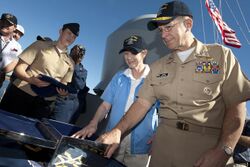Engineering:Mast Stepping

In sailboating and shipbuilding, Mast Stepping is the process of raising the boat's mast. It also refers to a ceremonial occasion which occurs when the mast is stepped, towards the end of a ship's construction. The ceremony involves placing or welding one or more coins into the mast step of a ship, and is seen as an important ceremonial occasion in a ship's construction which is thought to bring good luck.[1][2] Although the coins were originally placed under the main-mast of a ship, they are now generally welded under the radar mast or laid in the keel as part of a keel laying ceremony.
History
The ceremonial practice is believed to originate from ancient Rome. One theory is that, due to the dangers of early sea travel, the coins were placed under the mast so the crew would be able to cross to the afterlife if the ship were sunk. The Romans believed it was necessary for a person to take coins with them to pay Charon, in order to cross the river Styx to the afterlife and as a result of this, coins were placed in the mouths of the dead before they were buried.[3] Another theory for this practice is that the insertion of coins in buildings and ships may have functioned as a form of sacrifice thanking the gods for a successful construction, or a request for divine protection in the future.[4][5]
See also
References
- ↑ Marine Link:Bertholf Reaches Milestone With Mast Stepping Ceremony July 19, 2007
- ↑ Fox8:Mast stepping a special tradition[yes|permanent dead link|dead link}}]
- ↑ Mast Step
- ↑ Carlson, Deborah N. 2007. "Mast-Step Coins Among the Romans." IJNA 36:317-24
- ↑ Museum of London:Votive Deposits retrieved 26 October 2009
Further reading
- Hennington, H. 1965. "Coins for Luck under the Mast." Mariner’s Mirror 51:205-10.
- Houghtalin, Liane. 1984. "Roman Coins from the River Liri III." NC 145: 67-81.
- Marsden, P. 1965. "The Luck Coin in Ships." Mariner’s Mirror 51:33-4.

